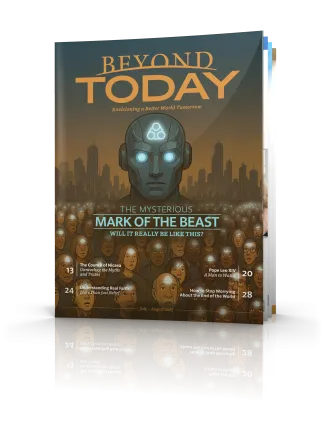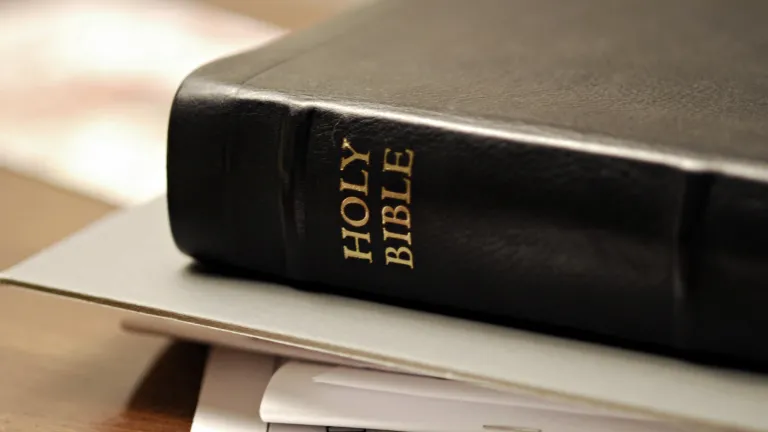The Mysterious Mark of the Beast: Part 1 - Identifying the Beast and Its Image

As the electronic surveillance society grows along with calls to implement digital currency, so too does concern about what Bible prophecy calls the mark of the Beast. To understand, we begin with what the Bible says about the Beast and its partnership with a false worship system.
Many have had rising concerns of late over the infamous “mark of the Beast” mentioned in the book of Revelation. This mark, with its associated number 666, is regarded as a sign of the devil to be received in the hand or forehead—Revelation 13:17 stating that no one may buy or sell without it.
Various explanations have been proposed. Some imagine a supernatural demonic branding. Others have claimed the mark is a tattooed or stamped barcode, a microchip embedded under the skin or an access code for money transactions in a cashless society. A few years ago some connected the mark with new smartphone apps or wristbands for contact tracing in monitoring Covid-19 transmission. Others related it to Covid vaccines or proof of vaccination passports, some even claiming the vaccines included injectable data technology.
Today, the idea that the mark concerns a shift from cash has gained ground with proposals for governments issuing Central Bank Digital Currency (CBDC), with all accounts and transactions trackable and able to be locked. It’s recalled that Canadian authorities froze accounts of truck drivers involved in political protest in 2022, and that financial tyranny would be even easier to impose through state-controlled digital currency.
But just what is this mark of the Beast? Should we be concerned with it? To start, we begin with first asking, What is the Beast? And how is it linked to religious belief and practice?
Identifying the Beast
Both the Beast and its mark are presented in Revelation 13. Here the apostle John in vision saw a beast rising out of the sea with seven heads and ten horns, these heads bearing blasphemous names (Revelation 13:1). In the previous chapter he had seen a red dragon with seven heads and ten horns representing Satan the devil (Revelation 13:3; Revelation 13:9). So is the Beast of chapter 13 Satan? No, but they’re related. The dragon gives the Beast power and authority (Revelation 13:2), so the heads and horns in that sense spring from Satan.
The Beast is described as having parts of a leopard, a bear and a lion. This points us to another prophecy of beasts arising from the sea with a total of seven heads and ten horns in Daniel 7. Daniel 2 and 7 both foretell, in different imagery, a sequence of four great empires from the time of the prophet Daniel to the end-time establishment of the Kingdom of God at the return of Christ. In chapter 7, Daniel saw a series of four beasts—the first like a lion, the second like a bear, the third like a leopard with four heads, and the last terrible beyond any beast and with ten horns. These represent, in order, the ancient empires of Babylon, Persia, Greece and Rome—the latter continuing through a series of 10 revivals up through the end time, with the final revival still ahead. (Learn more in our study guide The Final Superpower.)
John sees these beasts combined into one, as succeeding empires swallowed up the former ones. The heads and horns represent both the kingdoms and their rulers. Indeed, the Beast John sees is both the Roman Empire and its ruler—from the ancient emperors to a final end-time dictator also referred to later in Revelation. The sea from which it arises represents churning chaotic forces and, as in Revelation 17:15, “peoples, multitudes, nations, and tongues.”
In Revelation 13:3-4, the Beast appears mortally wounded but then is healed, with all the world following and worshiping or submitting to the Beast as a great power. The deadly wound and healing occurred in the ancient fall of Rome and subsequent restoration of the empire under the Roman Emperor Justinian. And there is evidently a parallel with a final revival after the empire has apparently ceased to exist.
Revelation 13:5-10 present the Beast making war against God’s saints or set-apart people—true Christians—for 42 months. This period parallels prophetic mentions elsewhere of 1,260 days and “time and times and half a time” (3½ years)—one of these specifying the period in which a blasphemous “little horn” among the horns of the Roman beast persecutes God’s people (Daniel 7:25).
In Revelation 12 we see a mention of both 1,260 days and 3½ years as denoting times of persecution against God’s people—the former before Satan’s final assault on heaven and the latter after Satan is cast down. But the former, the 1,260 days of Revelation 12:6, evidently refers to 1,260 years of persecution during the Middle Ages, following a prophetic day-for-a-year interpretive principle (compare Numbers 14:34; Ezekiel 4:6; Isaiah 34:8). The latter, the 3½ years of Revelation 12:14, are the 1,260 literal days ahead that end with Christ’s return.
With this in mind, the 42 months of Revelation 13:5 appear on one level to refer to the 1,260 years from the time of Justinian’s imperial restoration in A.D. 554 to the abdication of Napoleon in 1814—a time of five successive revivals of the empire later pointed to in Revelation 17:9-10. Yet, on another level, the 42 months refer to the final persecution of the saints by the end-time Beast power for the 3½ years prior to Christ’s second coming—paralleling 42 months of Jerusalem being under its dominion in Revelation 11:2. (The Beast revival itself will have come on the world scene a while before this final 3½ years.)
A powerful church-state system—before and yet to come
The persecution described in Revelation 13 and other passages is something God’s people will have to endure when it comes on the world. Yet in many ways it already did come on the world—through the dominion of Rome when it was first a great power persecuting the early Christian Church, and later through the Middle Ages when the Roman church-state system continued to persecute God’s people. That was all precursor, a forerunner, to the final fulfillment yet to come. Let’s note more about the false church described here.
Revelation 13:11 introduces another beast, this one from the earth—not in contrast to the sea but to heaven, where this power claims to be from. It has two horns like a lamb, presenting itself as of Christ, but speaks as a dragon, the devil—the two horns signifying two-pronged authority, both civil and religious. It exercises all the authority of the initial Beast, the Roman power, and causes all to bow to this power after it’s revived (Revelation 13:12). This second beast performs false miracles and deceives people into making “an image to the beast” and rendering homage to it.
What is this image? There are various theories. The original Greek word eikon here meant a likeness, whether a statue or some other kind of representation. The explanation that seems to best fit the facts of history concerns what happened in the late Roman Empire. Philip Myers’ Ancient History says that “there had begun to grow up within the Roman Empire an ecclesiastical state [church government], which in its constitution and its administrative system was shaping itself upon the imperial model”—a “spiritual empire” ruling over regions, with primacy eventually going to the bishops of Rome (1904, sec. 607). And this system continued beyond Rome’s fall.
Famed historian Will Durant explains: “The survival of ecclesiastical organization appeared even to the emperors as the salvation of the state. In 554 Justinian promulgated a decree requiring that ‘fit and proper persons, able to administer the local government, be chosen as governors of the provinces by the bishops and chief persons of each province’” (The Story of Civilization, Vol. 4, pp. 519-520, emphasis in original).
The system of Roman church governance was thus set up as a model, an image or copy, of the empire for all to submit to. As Durant further explains of this imperial church: “It became a triumphant Church by inheriting the organizing patterns and genius of Rome . . . As Judea had given Christianity ethics, and Greece had given it theology, so now Rome gave it organization . . . The Roman gift was above all a vast framework of government, which, as secular authority failed, became the structure of ecclesiastical rule. Soon the bishops, rather than the Roman prefects, would be the source of order and the seat of power in the cities; the metropolitans, or archbishops, would support, if not supplant, the provincial governors; and the synod of bishops would succeed the provincial assembly. The Roman Church followed in the footsteps of the Roman state” (Vol. 3, pp. 575, 618-619, emphasis added).
This church was polluted by doctrines from pagan mystery religions originating in ancient Babylon. We see another representation of this church as a corrupt woman called “Mystery, Babylon the Great,” sitting astride the revivals of the scarlet Roman beast in Revelation 17. The apostle Paul referred to this false system that was emerging in his day as the “mystery of lawlessness,” and the one who would lead it as “the man of sin,” who would perform lying wonders (2 Thessalonians 2). The head of this corrupt religious power is referred to in Revelation as the False Prophet, shown to be in partnership with the Beast dictator (see Revelation 16:13; Revelation 19:20). These would promulgate the persecution of those holding to the true teachings of the Bible.
Such an arrangement characterized the Holy Roman Empire through the Middle Ages and will return again in the end time. Europe today is very secular, but we will yet see an increase of false miracles to help drive it back to its religious underpinnings.
Be sure to read part 2 about the mark and number of the Beast.






